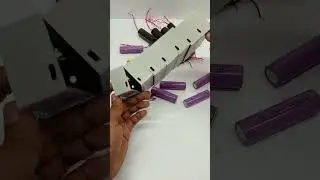Ampere's law with non-uniform current density: magnetic field of a thick cylindrical shell conductor
We compute the magnetic field of a thick cylindrical shell conductor carrying a total current of I, but this time the current density is not constant inside the conductor. Given a thick conducting cylindrical shell of inner radius a and outer radius b, we are also given a current density decreasing with distance from the symmetry axis as J=k/r. The goal of the problem is to calculate the magnetic field due to the conductor in all three regions: inside the inner radius a, outside the outer radius b, and between a radius of a and b, in other words, the magnetic field inside the conducting material itself.
00:00 Introduction: review of the problem setup, we plan to use Ampere's law with non-uniform current density to find the magnetic field of a thick cylindrical shell conductor.
00:54 Review of Ampere's Law and current density: quick review of Ampere's Law and the definition of current density, including pointing out the Amperian loop in the diagrams.
02:06 Magnetic field outside the conductor: the first trivial result for this problem is the magnetic field outside the conductor. We use an Amperian loop with a radius larger than the outer radius of the conductor, which means that it contains the entire current I as an enclosed current for the Amperian loop. We give a quick reminder of the direction of magnetic field according to the right hand rule and write down Ampere's law. The Ampere's law path integral is trivial in the usual way, reducing to B(2*pi*r), and we quickly solve for the magnetic field, obtaining the classic result B=mu_0*I/2pi*r. This is the same result we previously obtained for the magnetic field outside thin and thick wires.
03:37 Magnetic field inside the inner cavity of the thick cylindrical shell conductor: we apply Ampere's law to the hollow center of the thick shell wire, and this time the enclosed current is zero because there is no conductive material inside the hollow part! We quickly find the magnetic field inside the conductor: B=0.
04:20 Magnetic field in the conductive material itself: now we define an Amperian loop with a radius between a and b, so we can find the magnetic field within the conductive material itself. The path integral on the left hand side of Ampere's Law is trivial for all the same reasons and reduces to B(2pi*r). This time, the right hand side of Ampere's Law is the difficult part. How to compute enclosed current? This time the enclosed current is only part of the total current, and to make matters worse, the current density is variable, so we can't just multiply current density by cross sectional area to obtain the enclosed current! We have to use a calculus idea here: split the cross-sectional area into thin rings, and use the differential form of the current density formula: dI_enc=J*dA, where dA is the area contained in a thin ring. Now we can sub in the definition of the variable current density J=k/r' and find an expression for the enclosed current increment captured by the thin ring. We use an integral to add up all these contributions, sub into Ampere's law and calculate the magnetic field inside the thick shell.
08:47 Expressing the final magnetic field in terms of the total current I: We still need to express the magnetic field in terms of the total current, and this requires a second physical integral! This time we integrate over thin rings covering the entire cross section of the conductor, and this results in an expression relating the total current I to the constant in the varying current density k. We solve for k and sub into the result for magnetic field to find our final magnetic field inside the thick cylindrical shell conductor.
![[Raw, Boring] Four Random Landings](https://images.mixrolikus.cc/video/wacFCUJeWzc)






